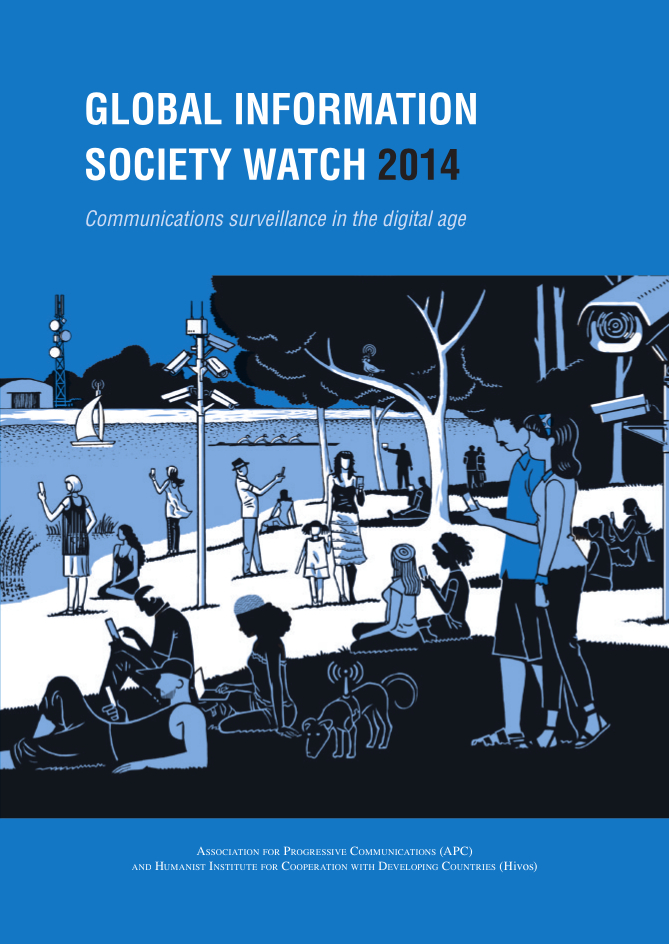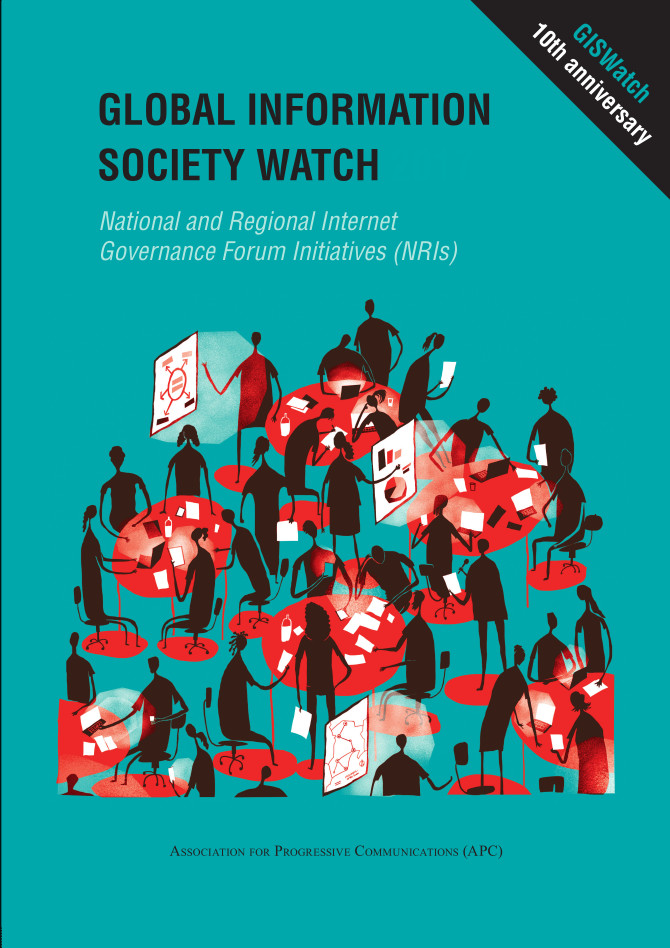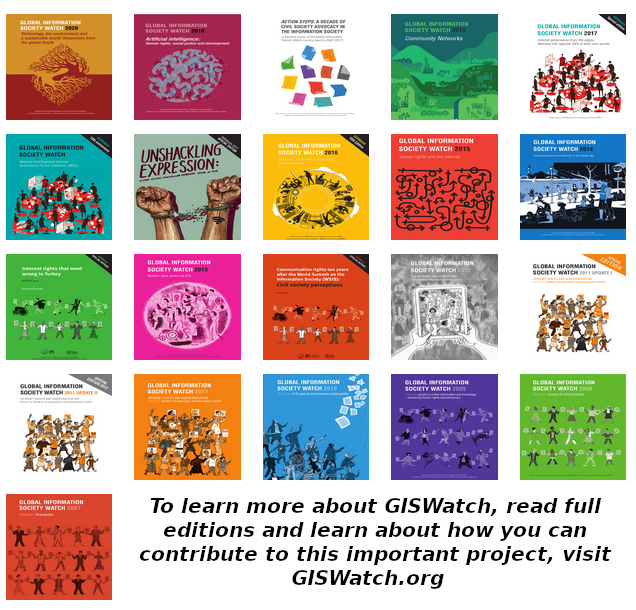
This piece is the third installment of a series celebrating 15 years of APC’s publication, Global Information Society Watch (GISWatch), exploring the origins of this powerful project while looking toward the future. We delve into reflections of what it means to write for this long-running project with Y. Z. Ya'u, a long-time Nigeria-based contributor to the report.
I cannot now remember where or when I first heard someone speak about GISWatch. Since it was in a conversation, I assumed GISWatch was some technology cliché. Only when I came across the 2014 report, Communications Surveillance in the Digital Age, did I decode GISwatch meant Global Information Society Watch. After reading that volume, it resonated with me because one of the objectives of the Centre for Information Technology and Development (CITAD) for which I work is to “monitor the application of ICTs in society”. Another objective is to “propagate best practices in ICTs applications for development”.

[Image: 2014 edition of GISWatch on Communications Surveillance in the Digital Age]
I found in GISWatch not only a practical way of delivering this first quoted objective of my organisation but also a means of achieving the second; that is, propagating the best practices in ICTs applications for development. In its various critiques and observations, GISWatch is providing alternative ways of conceptualising how ICTs should be deployed. I found what speaks to me the most is the volume on ICTs and Environmental Sustainability. It raised questions about e-waste, extractivism and how these can be responded to through greening. E-waste is something I see on a daily basis all around me in Nigeria and can therefore easily relate to the challenges posed by it.
At about the time I came into contact with GISWatch, I was also coordinating a multinational research team on behalf of the Dakar-based Council for the Development of Social Science Research in Africa (CODESRIA) on Africa in the Information Age. Reading that volume of GISWatch confirmed my framework for approaching ICT in Africa: not just the simple narrative of bringing more technology to the continent but also how that technology is introduced and disseminated within the continent. I became enthralled and promised myself that I would one day contribute to future editions of GISWatch.
That opportunity came in 2016 when I saw an invitation for prospective contributors to write on the National and Regional Internet Governance Forum Initiatives (NRIs). I was already active in the Nigerian NRI and had observed a lot of its modes of operation as well as the challenges it was facing, and therefore had readymade material to pen a contribution. I teamed up with my colleague from the Fantsuam Foundation, Dr. John Dada, for this effort. Since then, I have continued to contribute articles, although last year I thought it was important to make way for other people within Nigeria also to contribute.

[Image: 2017 edition of GISWatch on National and Regional Internet Governance Forum Initiatives (NRIs)]
For me, GISWatch reports offer accessible, jargon-free and easy analyses of various policies and practices around and about ICTs while articulating alternatives and focusing on justice, sustainability and citizen agency. Because the contributors are writing with the benefit of engagements, drawing from their own participation, the reports are not abstract projections or academicism but lived analyses that are rich in what human beings are doing to appropriate, re-appropriate and contest technology in ways that make sense in their lives. This is enough motivation for one to continue to engage with GISWatch. I guess, like most contributors, once you make your first contribution, it becomes difficult not to continue to contribute.
What I find most enjoyable in preparing an article for GISWatch, even when it is a single-contributor piece, is the ability to engage colleagues as a sounding board, allowing me to get a feel of what I am communicating. Also, I like the editorial process, when an editor flags to tell you that the point you are making is not clear. That process brings out the best in us contributors.
What sets GISWatch apart from other research publications is that researchers here are freed from pandering to commercial imperatives of sponsors looking to profit from publications. Contributors are also insulated from institutional sensitivity to critical perspectives that result in some research outcomes being thrown out for perceived ideological overreach. Contributors also write without academic pretentions that obfuscate rather than explain.
This, along with the fact that the editors of GISWatch are able to focus on crucial issues pertaining to information society – both in its making and in its actual substantiation – as well as their ability to predict future challenges, keeps GISWatch relevant year after year. The themes that they select annually are not disparate but are all linked in an unbroken way year after year, and provide a continuing logic and refreshing perspectives. Even when themes are repeated, they usually have a fresh insight that provides a contextual framing that makes you realise this has not been discussed before.
There is also the fact that GISWatch is not continent-centric, meaning that it is actually global. This allows you to observe information technology or issues around the application of information technology in different contexts. The reports give you a comparative coverage of the specific theme each year in various contents (countries, regions and continents), enabling readers to see how economy, culture and social formation interact in shaping the way technology is deployed, the result of such deployment, and the role citizens’ agency that comes to play in the equation.
I like the intersectionality of the perspectives presented in the reports. Such concerted effort to project the marginalised and excluded people, creating the space for their voices and amplification of such voices, are rarely seen in other research projects. There is also a deliberate effort in promoting a multi-sectoral perspective, something necessary for dealing with the complexity of issues in the search for sustainability in a world that is too comfortable with linearity. Some of the perspectives and innovative thinking I have seen in these reports relating to ICTs, environment and sustainability, I have not seen even in core environmental justice movements.
[Video: Y. Z. Y'au speaking about environmental justice at the Internet Governance Forum 2020]
I see academics – both students and faculty – reading and making use of GISWatch. I see activists engaging with it and I see policymakers referring to it. Even manufacturers have reason not to disregard what the reports present. While there is still relatively low awareness about the reports, they serve the useful purpose of making actors rethink some of the policies they have been implementing/engaging and to pause and reflect on the results that such policies have been producing.
I would love to see the stakeholders of GISWatch do more to spread awareness about the reports and disseminate them to wider audiences because they are a goldmine for all kinds of actors in cyberspace. GISWatch is a distinctively rich and compelling voice that is informed by experience, and needs to be heard across different demographics, spaces and actors. Perhaps that is an additional responsibility for the contributors also: going beyond their writing, they should also help bring the reports to the notice people in their respective countries.
GISWatch 15th anniversary series
- Part I: This inaugural piece by long-time GISWatch editor Alan Finlay is the first in a series that celebrates and examines how far we've come and where we need to head next. Read more.
- Part II: This second installment by APC's former executive director Anriette Esterhuysen considers how GISWatch has forged its own path by bringing together theory and action, evidence and experience. Read more.
- Part III: This third installment explores reflections of what it means to write for this long-running project with Y. Z. Ya'u, a long-time Nigeria-based contributor to the report. Read more.
- Part IV: The fourth installment examines how the initial support for GISWatch led to a strong and impactful collaboration with the Swedish International Development Cooperation Agency. Read more.
- Part V: This the fifth installment connects us with Pablo Accuosto, the project's first coordinator, who explains how GISWatch developed into a groundbreaking publication and fundamental source of information. Read more.
- Part VI: The sixth installment comes from Florencia Roveri, a long-standing author from Nodo TAU who has been contributing significantly to Argentina country reports since the inception of GISWatch. Read more.
- Part VII: The seventh installment considers the reflections of researchers around the globe who have contributed to the report year after year, including the latest edition, GISWatch 2021-2022: Digital futures for a post-pandemic world. Read more.
